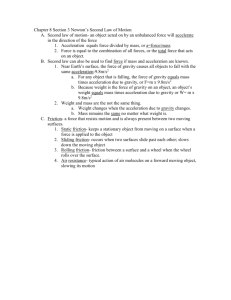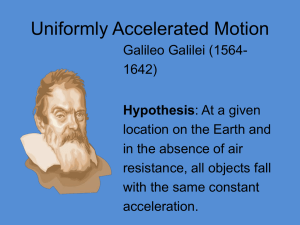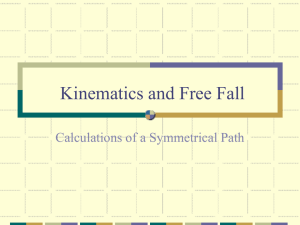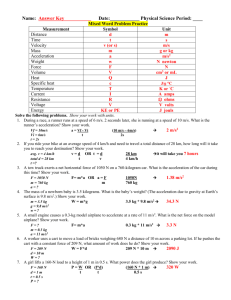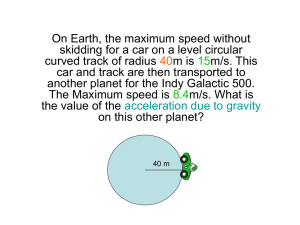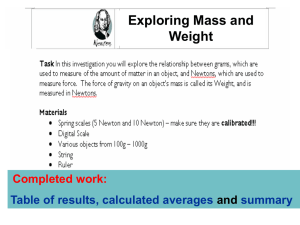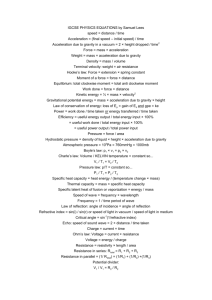Which equation to use? - Zeal Educational Services
advertisement
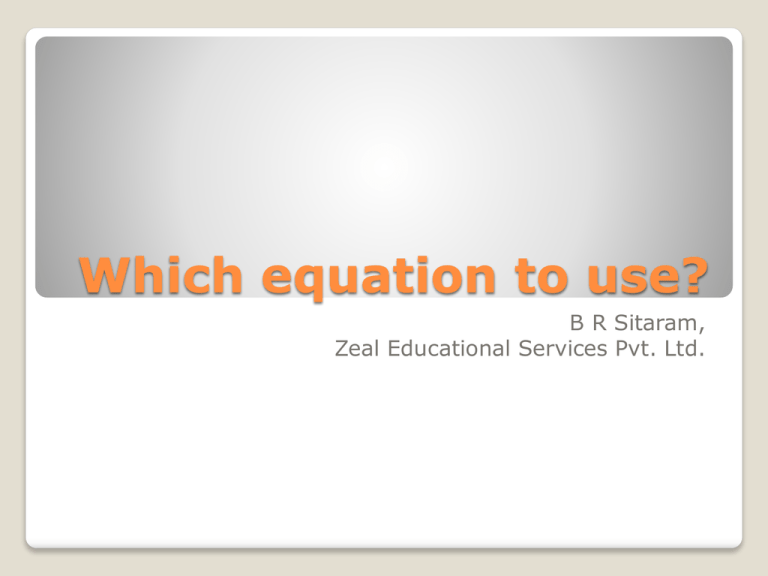
Which equation to use? B R Sitaram, Zeal Educational Services Pvt. Ltd. When students learn the equations of motion with constant acceleration, they often get confused: which equation should we use in a given situation? This presentation shows a simple way of deciding! Which Equation to use? First list the variables that we use: 1.t: time 2.s: distance 3.u: initial speed 4.v: final speed 5.a: acceleration Two more variables that can be removed easily: s0: initial position and t0: initial time. Which Equation to use? Write the equations: 1. s = u t + 1/2at2 2. v = u + a t 3. v2-u2=2 a s Make a table, showing which are the variables used in each equation: Which Equation to use? t s u v a v = u + at Y N Y Y Y s = ut+1/2at2 Y Y Y N Y v2 – u2 = 2as N Y Y Y Y Note: Each equation involves four of the five variables! Two equations appear to be missing: one not involving u and one not involving a. They are: s = vt – 1/2at2 s = t(u+v)/2 Which Equation to use? t s u v a v=u+at Y N Y Y Y s = u t + ½ a t2 Y Y Y N Y v2 – u2 = 2 a s N Y Y Y Y s = v t - ½ a t2 Y Y N Y Y s = t (u + v)/2 Y Y Y Y N Which Equation to use? In all problems: 4 variables will be referred to 3 will be given, 1 to be determined Use the table and determine which equation to use Solve the equation! Which Equation to use? Example: I throw a ball up with speed u against gravity. How much time does it take to reach the top of its motion? Variables: u, a (gravity), v (= 0 at top), t (to be determined) Hence use v = u + a t Which Equation to use? Example: I throw a ball up against gravity. It takes 2 sec to reach the top of its flight. To what height does it go? Variables: v (=0 at top), t, a (gravity), s (to be determined) Hence, use s = v t – ½ a t2 Which Equation to use? Example: The Lamborghini Murcielago can accelerate from 0 to 27.8 m/s (100 km/hr or 62.2 mi/hr) in a time of 3.40 seconds. Determine the acceleration of this car in both m/s/s and mi/hr/s. Variables: u (=0), v (=27.8 m/s), t (3.40 s), a (to be determined) Hence, use v = u + a t Which Equation to use? Example: A Formula One car is a single-seat racing car with an open cockpit and substantial wings located in the front and rear. At high speeds, the aerodynamics of the car help to create a strong downward force which allows the car to brake from 27.8 m/s (100 km/hr or 62.2 mi/hr) to 0 in as small of a distance as 17 meters. Determine the deceleration rate (i.e., acceleration) achieved by such a car. Variables: u (=27.8 m/s), v (=0), s (17m), a (to be determined) Hence, use v2 – u2 = 2as Which Equation to use? Example: A plane has a takeoff speed of 88.3 m/s and requires 1365 m to reach that speed. Determine the acceleration of the plane and the time required to reach this speed. Variables: u (=0), v (=88.3 m/s), s (=1365 m), a (to be determined in 1st part), t (to be determined in 2nd part) 1st part: (u, v, s, a), use v2-u2=2as 2nd part: (u, v, s, t), use s = t (u + v)/2 (You can in fact use any equation for part 2, as 4 out of the 5 variables are now known!) Which Equation to use?



